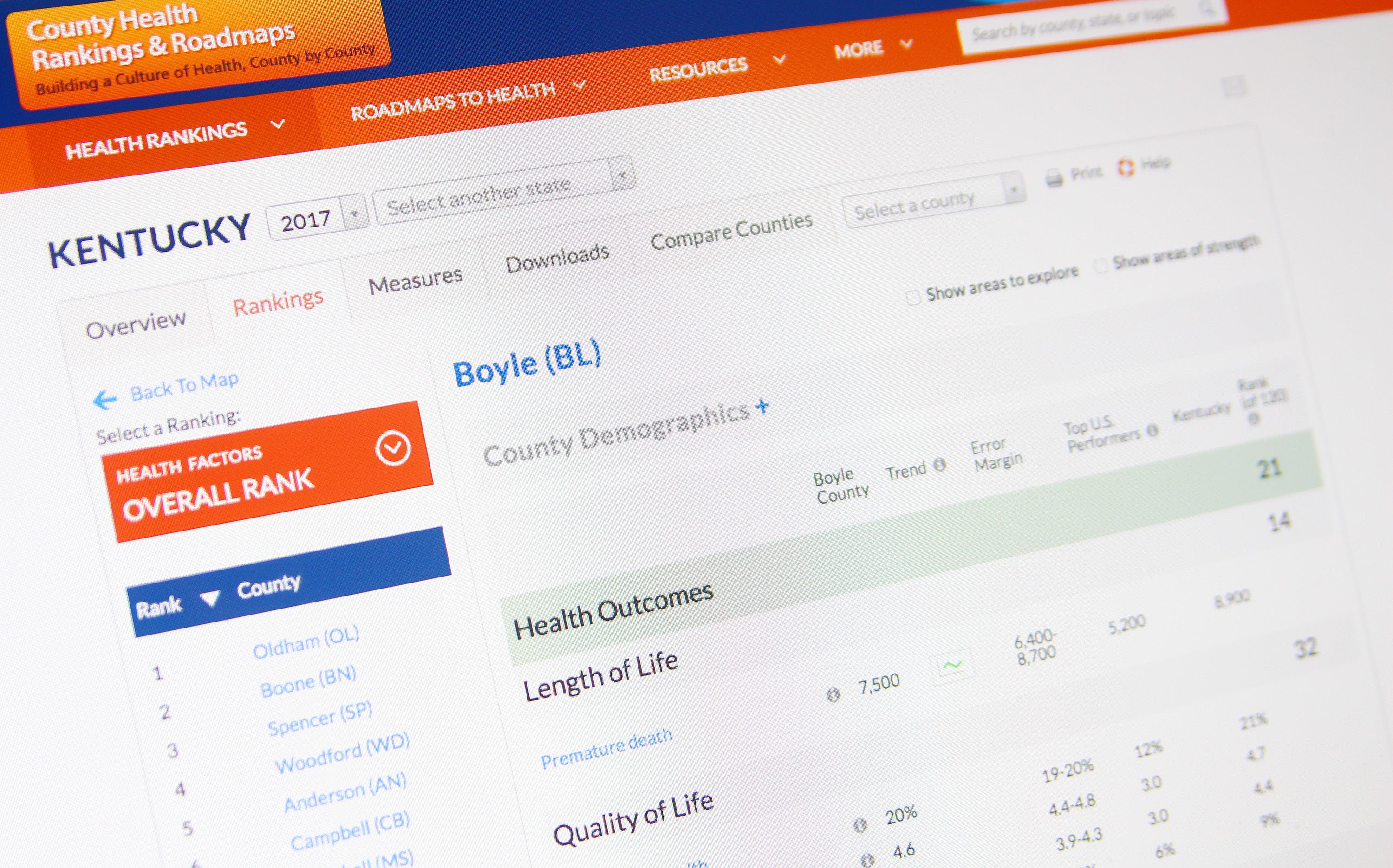Boyle’s health rankings improve in 2017
Published 8:32 am Thursday, April 13, 2017

- Ben Kleppinger/ben.kleppinger@amnews.com Boyle County’s health rankings — according to The County Health Rankings & Roadmaps released this month by the Robert Wood Johnson Foundation — improved somewhat compared to the rest of the state.
Boyle County’s health rankings improved somewhat relative to the rest of Kentucky in annual county-by-county health rankings released this month by the Robert Wood Johnson Foundation.
The rankings grade every county in the U.S. in two major health categories — “health outcomes,” which is focused on quality of life and length of life; and “health factors,” which takes into account a wide variety of health indicators, including obesity rates, drug and alcohol use, and educational attainment.
Boyle County was ranked 21st in the state for health outcomes and 14th in the state for health factors. Those are both improved from the county’s 25th and 19th places in 2016.
In counties surrounding Boyle County:
• Casey County was 81st in outcomes and 99th in factors;
• Garrard County was 64th in outcomes and 54th in factors;
• Lincoln County was 79th in outcomes and 77th in factors;
• Marion County was 56th in outcomes and 27th in factors;
• Mercer County was 34th in outcomes and 30th in factors; and
• Washington County was 11th in outcomes and 18th in factors.
Boyle County’s obesity and physical inactivity rates, both of which are factored into its health factors ranking, are in line with the state average: Boyle’s obesity rate is 32 percent and its physical inactivity rate is 31 percent; Kentucky’s average rates are 33 percent and 28 percent, respectively.
That was unexpected for Boyle Health Department Director Brent Blevins, who said he anticipated Boyle being better than the state in those categories. Boyle County has a lot of excellent parks and natural areas that feature walking trails and bike trails. There are a lot of groups in the area who make an effort to stay fit and help others get physical activity, he said.
“It’s surprising to me in the community of Danville and Boyle County that our inactivity is so high,” he said.
Blevins said Boyle’s obesity rate is “concerning.” Top performing communities in the U.S. have obesity rates of about 26 percent, which is well below Boyle’s 32 percent, he said.
There are plenty of bright spots in the findings for Boyle, however. Blevins pointed out a few that stood out to him:
• Boyle’s premature death rate is substantially lower than the state average. “Obviously, having Ephraim (McDowell Regional Medical Center) here as a major hospital helps with that,” Blevins said, noting there are many private practice doctors in the area as well. Boyle’s smoke-free ordinance that bans smoking in public places also helps improve length of life, Blevins said.
• Speaking of smoking, Boyle’s adult smoking rate is 21 percent — 5 percentage points below the state average.
• Alcohol-impaired driving deaths are rarer in Boyle County than in Kentucky as a whole. An estimated 17 percent of driving deaths in Boyle County in the most recent year data is available — 2014 —involved alcohol intoxication. The state average for the same year was 28 percent. Blevins said the Boyle County Agency for Substance Abuse Policy and local schools should be credited with helping on that statistic. “In the last couple years in particular, I think a lot of word is starting to get out to a lot of people about no drinking while you’re driving,” he said.
• Boyle has better ratios of doctors and dentists. In Kentucky, there’s one doctor for every 1,500 people and one dentist for every 1,620. In Boyle, there’s a doctor for every 1,100 people and a dentist for every 1,350.
• Boyle’s high school graduation rate is 95% — right in line with the top performing areas in the entire nation. Kentucky’s average is 89 percent.
• Only 26 percent of children in Boyle County live in single-parent households, compared to 35 percent of children in Kentucky.
• Boyle County has about 35 teen births for every 1,000 females between the ages of 15 and 19; Kentucky’s rate is 25 percent higher at 44 teen births.
One area where Boyle’s statistics are worse than the state average is sexually transmitted infections. Boyle has about 469 newly diagnosed chlamydia cases for every 100,000 people, while the state has about 402 on average. Boyle County has been above the state and national averages in this category for the past five years of rankings, and above the state average alone for the past seven years, according to the health rankings data.
Blevins said he’s not sure what could be driving that statistic. It’s not a statistic affected by the current opioid drug epidemic, which has put Boyle County at risk for an outbreak of HIV or hepatitis C among injection drug users — that’s a different problem not measured by the figure in the health rankings.
It’s possible that Boyle County’s STI rate actually looks worse because other counties may not report their statistics as fully or accurately as Boyle does, Blevins said.
“I think that’s a positive for us because it means we have a truer number,” he said.
The 2017 County Health Rankings and Roadmaps program is a project of the Robert Wood Johnson Foundation and the University of Wisconsin Population Health Institute. Rankings for all states and counties in the U.S. going back to 2011 are available online at countyhealthrankings.org.





